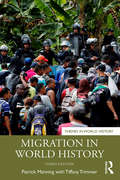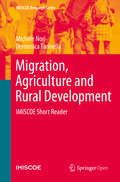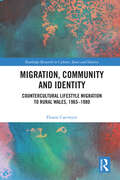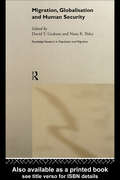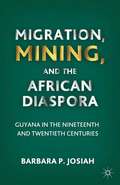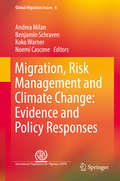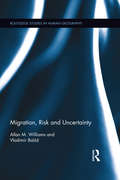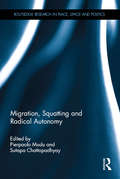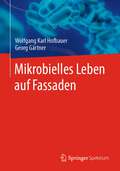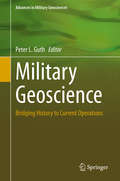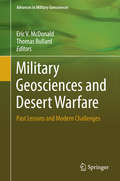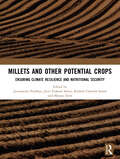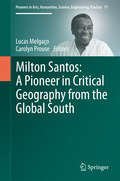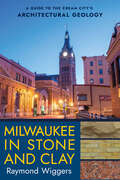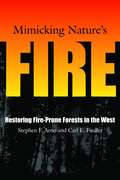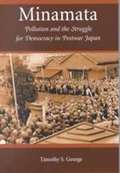- Table View
- List View
Migration in World History (Themes in World History)
by Patrick Manning Tiffany TrimmerIn this third edition of Migration in World History, Patrick Manning presents an expanded and newly coherent view of migratory processes, conveying new research and interpretation. The engaging narrative shows the continuity of migratory processes from the time of foragers who settled the earth to farmers opening new fields and merchants linking purchasers everywhere. In the last thousand years, accumulation of wealth brought capitalism, industry, and the travels of free and slave migrants. In a contest of civilizational hierarchy and movements of emancipation, nations arose to replace empires, although conflicts within nations expelled refugees. The future of migration is now a serious concern. The new edition includes: An introduction to the migration theories that explain the shifting patterns of migration in early and recent times Quantification of changes in migration, including international migration, domestic urbanization, and growing refugee movements A new chapter tracing twenty-first-century migration and population from 2000 to 2050, showing how migrants escaping climate change will steadily outnumber refugees from other social conflicts While migration is often stressful, it contributes to diversity, exchanges, new perspectives, and innovations. This comprehensive and up-to-date view of migration will stimulate readers with interests in many fields.
Migration, Agriculture and Rural Development: IMISCOE Short Reader (IMISCOE Research Series)
by Domenica Farinella Michele NoriThis open access short reader looks into the dynamics which have reshaped rural development and human landscapes in European agriculture and the role of immigrant people. Within this framework it analyses contemporary rural migrations and the emergence of immigrants in relation to the incorporation of agrarian systems into global markets, the European agricultural governance (CAP), and the struggle of local territories as differentiated practices in constant stress between innovation and resilience. It specifically explores the case of immigrant shepherds to describe the reconfiguration of agriculture systems and rural landscapes in Europe following intense immigration and the related provision of skilled labour at a relatively low cost. Being written in a very accessible way, this reader is an interesting read to students, researchers, academics, policy makers, and practitioners.
Migration, Community and Identity: Countercultural Lifestyle Migration to Rural Wales, 1965-1980 (Routledge Research in Culture, Space and Identity)
by Flossie CaerwyntMigration, Community and Identity analyses experiences of migration to rural Wales from 1965-1980. It focuses on people who were part of the era’s counterculture, looking for an escape from mainstream society. Using original interviews, the book shows why people moved and how the move shaped their lives and identities. Drawing together geographical and historical research, this book explores the significance of this migration phenomenon. It provides a unique insight into late 20th century Welsh society and shines a new light onto the counterculture itself. Through analysing the experience of life in Wales, and ongoing developments to the migrants’ sense of identity, it argues that rather than being a uniform group, the counterculture encompassed a diverse range of beliefs and aspirations. The book will be suitable for upper-level undergraduates and above, the broad range of themes covered in this book is relevant not only to rural and historical geographers and migration researchers, but also those interested in sociology, anthropology, and the modern history of Britain and Wales. The theories and concepts discussed have global appeal and will be of interest to those studying similar migration phenomena elsewhere.
Migration, Globalisation and Human Security (Routledge Research in Population and Migration #Vol. 2)
by David T. Graham Nana K. PokuMigration, Globalisation and Human Security looks at a range of security and human security issues related to the displacement of civilian populations and shows how the tenuous existence of migrants can lead to a myriad of human security threats. Providing major theoretical analyses of recent migration trends and in depth-case studies, this book shows that a redefinition of the notion of human security is now needed.
Migration, Mining, and the African Diaspora
by Barbara P. JosiahFrom the late 1800s, African workers migrated to the mineral-rich hinterland areas of Guyana, mined gold, diamonds, and bauxite; diversified the country's economy; and contributed to national development. Utilizing real estate, financial, and death records, as well as oral accounts of the labor migrants along with colonial officials and mining companies' information stored in National Archives in Guyana, Great Britain, and the U. S. Library of Congress, the study situates miners into the historical structure of the country's economic development. It analyzes the workers attraction to mining from agriculture, their concepts of "order and progress," and how they shaped their lives in positive ways rather than becoming mere victims of colonialism. In this contentious plantation society plagued by adversarial relations between the economic elites and the laboring class, in addition to producing the strategically important bauxite for the aviation era of World Wars I & II, for almost a century the workers braved the ecologically hostile and sometimes deadly environments of the gold and diamond fields in the quest for El Dorado in Guyana.
Migration, Risk Management and Climate Change: Evidence and Policy Responses
by Andrea Milan Benjamin Schraven Koko Warner Noemi CasconeThis edited volume explores the circumstances under which vulnerable communities can better adapt to climate and environmental change, and focuses in particular on the centrality of migration as a resilience and adaptation strategy for communities at risk. The book features important case studies where migration is being used as a risk management strategy in the Pacific, Sub-Sahara Africa, Latin America, and Europe. Its comparative analysis reveals common patterns in enhancing local resilience through migration across diverse regional, socio-economic, cultural, and political contexts. This book is a contribution to the global discussion about the future of migration policy, especially as climate and environmental change is expected to grow as one of the most pressing challenges of our time.
Migration, Risk and Uncertainty (Routledge Studies in Human Geography #53)
by Allan M. Williams Vladimír BalážMigration is one of the driving forces of economic and social change in the modern world. It is both informed by risk and a generator of risk, whether for individuals, households, communities or societies. Although the relationship between migration and risk is widely acknowledged, it has long been neglected in academic research, with a few exceptions such as household diversification strategies. Instead, risk is assumed to be implicit in economic or social models, rather than being explicitly theorised or analysed. This book represents the first major review of these key relationships. It draws on a wide range of theories - from economics, psychology, sociology, anthropology and geography - and an equally broad range of empirical material, to provide a highly original overview.
Migration, Squatting and Radical Autonomy: Resistance and Destabilization of Racist Regulatory Policies and B/Ordering mechanisms (Routledge Research in Place, Space and Politics)
by Pierpaolo Mudu Sutapa ChattopadhyayThis book offers a unique contribution, exploring how the intersections among migrants and radical squatter’s movements have evolved over past decades. The complexity and importance of squatting practices are analyzed from a bottom-up perspective, to demonstrate how the spaces of squatting can be transformed by migrants. With contributions from scholars, scholar-activists, and activists, this book provides unique insights into how squatting has offered an alternative to dominant anti-immigrant policies, and the implications of squatting on the social acceptance of migrants. It illustrates the different mechanisms of protest followed in solidarity by migrant squatters and Social Center activists, when discrimination comes from above or below, and explores how can different spatialities be conceived and realized by radical practices. Contributions adopt a variety of perspectives, from critical human geography, social movement studies, political sociology, urban anthropology, autonomous Marxism, feminism, open localism, anarchism and post-structuralism, to analyze and contextualize migrants and squatters’ exclusion and social justice issues. This book is a timely and original contribution through its exploration of migrations, squatting and radical autonomy.
Migration: Exploring the Remarkable Journeys of Birds
by Melissa MayntzWINNER OF THE SILVER MEDAL IN THE ANIMAL & NATURE CATEGORY OF THE NAUTILUS AWARDS 2022Flight has fascinated humans since we first looked into the sky and saw birds on the wing, and no flights are more fascinating than the extraordinary migrations birds make every day, week, month, and season of the year.Migration explores how birds make these incredible expeditions. From first preparing to migrate, to the different types of migration and the compelling reasons why it is a must. From the high-flying adventures of bar-headed geese that soar above the Himalayan Mountains and the long-distance endurance of Arctic terns that travel from pole-to-pole, birds of all families, from vast seasonal migrators to the more casual nomad, will be explored. As readers migrate through the book’s pages, they will also discover avian navigation, curious routes, the hazards of the journey, and why, occasionally, birds end up far from their original destination. Beautifully illustrated, this book will debunk the most outrageous myths about migration as it thoroughly travels the globe exploring the epic journeys these incredible birds make.
Mikrobielles Leben auf Fassaden
by Georg Gärtner Wolfgang Karl HofbauerArchitekten, Bauingenieure, Bausachverständige und andere Fachleute sowie Bauherren, Wissenschaftler und Masterstudenten finden in diesem Buch alle Informationen zu Fassadenalgen und -pilzen. Es gibt einen detaillierten Überblick über die Mikroorganismen, die das anfängliche Wachstum an den Außenfassaden von Gebäuden bilden und befasst sich mit den ökophysiologischen Eigenschaften, die die Rahmenbedingungen charakterisieren, unter denen diese Mikroorganismen an Fassaden auftreten können. Neben einem Bestimmungsschlüssel für die charakteristischen Anflüge an Fassaden von Mikroorganismen enthält dieses Buch eine ausführliche Beschreibung der einzelnen Organismen unter Angabe ihres ökologischen Verbreitungsgebiets. Darüber hinaus werden die verschiedenen ökologischen Parameter in kurzen Kapiteln diskutiert. Auch Maßnahmen zur Vorbeugung und Bekämpfung der Besiedelung von Fassaden mit Mikroorganismen werden thematisiert.
Mikromagnetische Charakterisierung des Ermüdungsverhaltens und der Eigenspannungsrelaxation tiefgebohrter Proben des Vergütungsstahls 42CrMo4 (Werkstofftechnische Berichte │ Reports of Materials Science and Engineering)
by Nikolas BaakNikolas Baak befasst sich mit der Qualifizierung mikromagnetischer Methoden zur Bewertung der durch Tiefbohren erzeugten Randzonen hinsichtlich ihrer Oberflächenintegrität und deren Einfluss auf das Ermüdungsverhalten. Dabei wird das Ziel verfolgt, durch den Bohrprozess einen vorteilhaften Eigenspannungszustand zu erreichen. Beim hier eingesetzten Einlippen-Tiefbohren kommt es aufgrund des asymmetrischen Werkzeugaufbaus zu einer Art Festwalzprozess. Dadurch werden sowohl sehr hohe Oberflächengüten, als auch der gewünschte Druckeigenspannungszustand erzeugt. Da die meisten Verfahren zur Bestimmung der Oberflächenintegrität entweder zerstörend sind oder auch einen freien Zugang zur Oberfläche benötigen, werden hier zerstörungsfreie Prüfverfahren dafür ertüchtigt, die Oberflächenintegrität sowie den Ermüdungszustand der Bauteile zu bestimmen. Für beide hier betrachteten mikromagnetischen Verfahren, einerseits die Barkhausenrauschen-Analyse und andererseits die Wirbelstromprüfung, werden speziell angefertigte Sensoren, welche das Messsignal an der Innenseite der Bohrung detektieren können, verwendet. Die Messdaten der mikromagnetischen Verfahren werden mit den etablierten Verfahren zur Bestimmung der Oberflächenintegrität, wie bspw. Röntgendiffraktometrie, korreliert.
Mikroplastik in der aquatischen Umwelt: Quellen, Senken und Transportpfade (essentials)
by Kryss WaldschlägerMikroplastik ist derzeit ein allgegenwärtiges Thema in den Medien und wird daher auch in der Bevölkerung als umweltrelevante Problematik wahrgenommen. Da jedoch viel Halbwissen zur Meinungsbildung beiträgt, bereitet dieses essential den aktuellen Forschungstand auf und stellt ihn allgemein verständlich dar. Angefangen bei den Grundlagen der Mikroplastikdefinition und den derzeit bekannten Quellen über bisher nachgewiesene Konzentrationen in der aquatischen Umwelt bis hin zu den Senken wird der Weg des Mikroplastiks durch die Gewässer dieser Erde beschrieben. Abschließend wird auf die Umweltrisiken, die Mikroplastik für die Ökosysteme, die aquatischen Organismen und den Menschen birgt, eingegangen. Dabei werden viele Wissenslücken aufgezeigt, die zukünftig geschlossen werden müssen und die innerhalb der üblicherweise kurzen Beiträge in Massenmedien so nicht präsentiert werden.Die Autorin: Kryss Waldschläger hat Bauingenieurwesen studiert und arbeitet derzeit als wissenschaftliche Mitarbeiterin am Institut für Wasserbau und Wasserwirtschaft der RWTH Aachen University. Dort untersucht sie im Rahmen ihrer Promotion das Transportverhalten von Mikroplastik in Fließgewässern.
Milanese Encounters
by Cristina MorettiIn a city driven by fashion and design, visibility and invisibility are powerful forces. Milanese Encounters examines how the acts of looking, recognizing, and being seen reflect social relations and power structures in contemporary Milan.Cristina Moretti's ethnographic study reveals how the meanings of Milan's public spaces shift as the city's various inhabitants use, appropriate, and travel through them. Moretti's extensive fieldwork covers international migrants, social justice organizations, and middle-class citizens groups in locations such as community centers, abandoned industrial areas, and central plazas and streets. Situated at the intersection of urban and visual anthropology, her work will challenge and inspire scholars in anthropology, urban studies, and other fields.Contributing to studies of urban Italy, neoliberalism, and immigration, Milanese Encounters is a welcome demonstration of ethnography's potential to analyse the connections and divisions created by complex modern cities.
Military Geoscience: A Multifaceted Approach to the Study of Warfare (Advances in Military Geosciences)
by Judy Ehlen Aldino BondesanThis volume presents a selection of papers from the 13th International Conference on Military Geosciences (ICMG), held 24-28 June 2019 in Padua, Italy. It covers a wide range of subjects within the confines of military geoscience written by scientists with a variety of different backgrounds from many countries throughout the world. Many of the papers focus on subjects related to Italy and World War I, but additional subject areas include international perspectives in the military geosciences, international security, geospatial intelligence and remote sensing, subterranean and underground warfare, analyses of historical battlefields and fortifications, and military archaeology. The book will be of interest to academics (e.g., military historians, military archaeologists, military geographers and geologists), applied geoscientists (e.g., engineering geologists and geologists working in other areas of applied geology), professional geoscientists, and those with a general interest in military geoscience and history.
Military Geoscience: Bridging History to Current Operations (Advances in Military Geosciences)
by Peter L. GuthThis book is a collection of papers presented at the 11th International Conference of Military Geoscience that was held in 2015. The conference included discussion on a diverse range of geosciences, including military history, military geology, teaching geology from a military prospective, geological influence on the battlefield, and environmental and cultural issues related to management of military lands. Geology and geography have played a significant role in military history, from providing the stone for primitive tools and weapons, to the utilization of terrain in offensive and defensive strategies. Specific to this volume, deserts comprise nearly a third of the Earth’s surface and have been the site of numerous battles where the dust, heat, and a lack of food and water have provided challenges to military leaders and warriors. This book examines the role of deserts in past and modern warfare, the problems and challenges in managing military lands in desert regions, and how desert environmental conditions can impact military equipment and personnel. This proceedings volume should be of interest to scholars, professionals, and those interested in military history, warfare, geology, geography, cultural resources, general science, and military operations.
Military Geosciences and Desert Warfare
by Eric V. Mcdonald Thomas BullardThis book is a collection of papers presented at the 9th International Conference of Military Geoscience that was held in 2011. The conference included discussion on a diverse range of geosciences, including military history, military geology, teaching geology from a military prospective, geological influence on the battlefield, and environmental and cultural issues related to management of military lands. Geology and geography have played a significant role in military history, from providing the stone for primitive tools and weapons, to the utilization of terrain in offensive and defensive strategies. Specific to this volume, deserts comprise nearly a third of the Earth's surface and have been the site of numerous battles where the dust, heat, and a lack of food and water have provided challenges to military leaders and warriors. This book examines the role of deserts in past and modern warfare, the problems and challenges in managing military lands in desert regions, and how desert environmental conditions can impact military equipment and personnel. This proceedings volume should be of interest to scholars, professionals, and those interested in military history, warfare, geology, geography, cultural resources, general science, and military operations.
Millennial Metropolis: Space, Place and Territory in the Remaking of London
by Tom HuttonThe text offers a critical perspective on complex and consequential aspects of growth and change in London, viewed through the lens of multiscalar space and brought to life through exemplary case studies. It demonstrates how capital, culture and governance have combined to reproduce London, within a frame of relational geographies and historical relayering. Emphasis is placed on the sequences of political change, capital intensification, industrial restructuring and cultural infusions which have transformed space in London since the 1980s. Tom Hutton contributes to the rich discourse on London’s experiences of urbanization, by producing a fresh perspective on its development saliency. Millennial Metropolis includes a systematic review and synthesis of research literatures on globalizing cities, with reference to the reproduction of space at the metropolitan, district and neighbourhood scales. Hutton offers a nuanced treatment of geographical scale, observed in the blending of global/transnational processes with the fine-grained imprint of governance processes and social relations. These proccesses are manifested in sites of innovation, spectacle and social conviviality, but also produce experiences of displacement and inequality. The author presents a spatial model of metropolitan development by exploring how growth and change in twenty-first-century London is expressed internally as an enlarged zonal structure extending beyond the traditional territories of central and inner London. Serious threats to London are discussed —from the isolating implications of Brexit, the impact of the Covid-19 pandemic and the dire threat of ecological crises and deteriorating public health associated with climate change. This will be an invaluable text for postgraduate students, established scholars and upper level undergraduates, across diverse disciplines and fields including geography, sociology, governance studies and planning and urban studies.
Millets Value Chain for Nutritional Security
by B. Dayakar Rao N. G. Malleshi George A. Annor J. V. PatilThe development of successful value chains to revive demand for traditional cereals such as millets plays an important role in ensuring health and nutrition security in India. Millets Value Chain for Nutritional Security: A Replicable Success Model from India demonstrates value addition to millets from production to consumption, covering chapters on nutritional evaluation, on-farm cultivation, intervention in food processing, entrepreneurship development, commercialization and popularization and policy sensitization. This book outlines practical interventions to revive the demand for millets as a convenient and nutritive option for consumers, while presenting a reliable model that can be adapted for the development of other commodities.
Millets Value Chain for Nutritional Security: A Replicable Success Model from India
by Jagannath Vishnu Patil Dr Benhur Dayakar Rao N G Malleshi George A AnnorThis book demonstrates a successful and sustainable model for value addition to millets from production to consumption. Within the work the authors outline practical interventions to revive the demand for millets as a convenient and nutritive option for consumers, whilst presenting a reliable model that can be adapted for the development of other commodities. Based on practical experience and the output of a National Agricultural Innovation Project, Millets Value Chain for Nutritional Security: A Replicable Success Model from India explores the development of an integrated approach to value addition to millets. All phases of the model are covered, including chapters on: · nutritional evaluation · on-farm cultivation · intervention in food processing · entrepreneurship development · commercialization · popularization and policy sensitization. The development of successful value chains to revive demand for traditional cereals such as millets plays an important role in ensuring health and nutrition security in India. As such, this book is an invaluable resource for researchers and advanced students in the fields of agriculture, food science and business management, in addition to policy makers, manufacturers and breeders.
Millets and Other Potential Crops: Ensuring Climate Resilience and Nutritional Security
by Jyoti Prakash Sahoo Jyostnarani Pradhan Manasi Dash Kailash Chandra SamalDeeply rooted in indigenous peoples’ culture and traditions, millets (also called ‘nutricereals’ are ancestral crops high in nutritional value. As the global agrifood systems face challenges to feed an ever-growing global population, resilient cereals like millets provide an affordable and nutritious option and help guarantee food security.This book presents the basic principles and practices of millets and other potential crops towards climate resilience and nutritional security. It discuses the role of millets in sustainable agriculture, the medicinal use of foxtail millet, exotic fruits in India, and climate-resilient fruit and vegetable crops.The goal of this work is to promote the sustainable cultivation of millets, also under adverse and changing climatic conditions and improving their quality, highlighting their potential to provide new sustainable market opportunities for producers and consumers.Print edition not for sale in South Asia (India, Sri Lanka, Nepal, Bangladesh, Pakistan or Bhutan)
Milton Santos: A Pioneer in Critical Geography from the Global South
by Lucas Melgaço Carolyn ProuseFor decades, Milton Santos (1926-2001) has been considered one of the most influential thinkers in Brazilian and Latin American social sciences and geography. Yet his writings, most of which have not been translated into English, are largely unknown to European and North American audiences. This book introduces English-speaking scholars to Professor Santos through critical engagement with his ideas and writings. The chapters presented here reveal the breadth and originality of his critical thought, as well as its ongoing importance to contemporary debates. The book features a biography of Santos and includes an annotated translation of one of his most-cited texts, The Return of the Territory, offered here for the first time in English. This text demonstrates how Santos's provocative insights continue to transform core concepts of political and human geography. The book also includes a number of short chapters written by scholars from Brazil, Spain and France. Through reflections on Santos's work, the various authors demonstrate the value and possibilities of extending the geographer's theories. They explore key geographical themes across political economy, rural studies, territorial planning, environmental crisis, digital networks, indigenous peoples, transportation and public health. This collection invites geographers from around the world to engage with this rich intellectual tradition from Brazil.
Milwaukee in Stone and Clay: A Guide to the Cream City's Architectural Geology
by Raymond WiggersMilwaukee in Stone and Clay follows directly in the footsteps of Raymond Wiggers's previous award-winning book, Chicago in Stone and Clay. It offers a wide-ranging look at the fascinating geology found in the building materials of Milwaukee County's architectural landmarks. And it reveals the intriguing and often surprising links between science, art, and engineering. Laid out in two main sections, the book first introduces the reader to the fundamentals of Milwaukee's geology and its amazing prehuman history, then provides a site-by-site tour guide. Written in an engaging, informal style, this work presents the first in-depth exploration of the interplay among the region's most architecturally significant sites, the materials they're made of, and the sediments and bedrock they're anchored in. Raymond Wiggers crafted Milwaukee in Stone and Clay as an informative and exciting overview of this city. His two decades of experience leading architectural-geology tours have demonstrated the popularity of this approach and the subject matter.
Mimicking Nature's Fire: Restoring Fire-Prone Forests In The West
by Carl E. Fiedler Stephen F. ArnoIn Mimicking Nature's Fire, forest ecologists Stephen Arno and Carl Fiedler present practical solutions to the pervasive problem of deteriorating forest conditions in western North America.
Minamata: Pollution and the Struggle for Democracy in Postwar Japan
by Timothy S. GeorgeNearly forty years after the outbreak of the “Minamata Disease,” it remains one of the most horrific examples of environmental poisoning. Based on primary documents and interviews, this book describes three rounds of responses to this incidence of mercury poisoning, focusing on the efforts of its victims and their supporters, particularly the activities of grassroots movements and popular campaigns, to secure redress.
Mind Blown! The Ultimate Science Book for Curious Kids: 250+ Amazing Facts About Space, Animals, Human Biology, and More!
by Shane CarleyDid you know there are clouds in space that taste like raspberries, or that your brain generates enough electricity to power a light bulb?Mind Blown! The Ultimate Science Book for Curious Kids takes young readers on an unforgettable journey through 250 of science's most astonishing discoveries. Perfect for ages 8-12 and guaranteed to amaze science lovers of all ages!This isn't your average science book—it's a mind-bending, jaw-dropping adventure that transforms complex concepts into captivating revelations that will have kids shouting, "THAT'S CRAZY!" on every page.Whether your child loves solving mysteries, discovering new wonders, or simply asking "How?" and "Why?" this book delivers an exciting exploration of science's most unbelievable (but totally true!) facts.Wild Animal Wonders: Meet the octopus with three hearts, learn why T. Rex's tiny arms could lift 400 pounds, and find out why some spiders can taste with their feetSpace Spectaculars: Journey to planets made of diamonds, witness cosmic storms that could swallow Earth, and explore black holes that bend the rules of physics.Mind-Blowing Science: From glow-in-the-dark animals to underwater volcanoes, uncover nature's most spectacular phenomena and strangest secrets.Screen-Free Entertainment: Keep curious minds engaged for hours with exciting facts, fun challenges, and mind-blowing discoveries on every page.Visual Adventure: Eye-popping illustrations and infographics bring science to life, turning complex concepts into easy-to-understand, unforgettable experiences.
